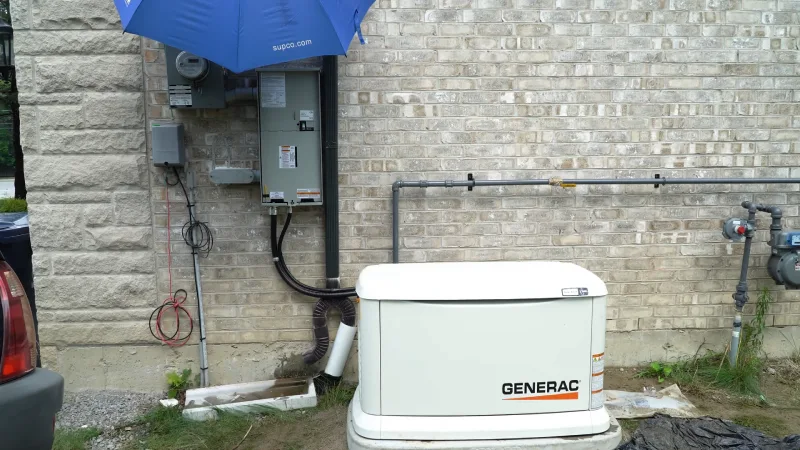What Size Wire is Between the 22kw Generator and the Transfer Switch?

When installing a 22kw generator, it’s important to carefully consider the size of the wire that will be used to connect the generator to the transfer switch. The size of the wire will impact the efficiency of the generator, as well as the overall safety of the installation.
In this article, we will explore the factors to consider when selecting the appropriate size wire for a 22kw generator installation, as well as provide information on how to calculate the necessary wire size. By understanding the importance of wire size and following the proper guidelines, you can ensure that your generator installation is safe and efficient.
You'll Learn About
Factors To Consider When Selecting Wire Size
1. Distance between the generator and transfer switch
The distance between the generator and the transfer switch can affect the size of the wire needed. As the distance increases, the wire size may need to be increased to compensate for voltage drop, which is the loss of electrical potential that occurs as electricity travels through a conductor.
2. Load on the generator
The load on the generator, or the amount of electrical current that the generator will be supplying, is another important factor to consider when selecting wire size. A larger load will require a larger wire size to ensure that the wire can safely handle the electrical current.
3. Voltage drop
Voltage drop is the loss of electrical potential that occurs as electricity travels through a conductor. It is important to consider voltage drop when selecting wire size, as excessive voltage drop can lead to inefficient operation of the generator.
4. Electrical codes and standards
It is important to follow local electrical codes and standards when selecting wire sizes for a generator installation. These codes and standards provide guidelines for safe and efficient electrical installations, and failure to follow them could result in problems with inspections or insurance coverage.
How To Calculate The Necessary Wire Size
To determine the necessary wire size for a generator installation, you can follow these steps:
Divide The Generator’s Wattage By The Voltage To Calculate The Amp Draw
The amp draw is the amount of electrical current that the generator will be supplying. To calculate the amp draw, divide the generator’s wattage by the voltage of the electrical system.
For example, if the generator has a wattage of 22,000 watts and is connected to a 240V electrical system, the amp draw would be 22,000 watts / 240 volts = 91.7 amps.
Use Ampacity Tables Or A Wire Size Calculator To Determine The Appropriate Wire Size
Once you have calculated the amp draw, you can use ampacity tables or a wire size calculator to determine the appropriate wire size based on the amp draw and the distance between the generator and the transfer switch.
Ampacity tables provide information on the maximum amount of electrical current that different sizes of wire can safely handle. Wire size calculators allow you to input specific information, such as the amp draw and distance, to determine the appropriate wire size.
It’s important to note that the wire size may need to be increased if the distance between the generator and the transfer switch is longer, or if the load on the generator is particularly high. It’s also important to follow local electrical codes and standards when selecting the wire size for your installation.
Minimum Wire Size
- The minimum wire size for hots and neutrals is #3 copper.
- The minimum wire size for ground is #6 copper.
Wire Size between 22kW Generator and Transfer Switch
- The wire size required between a 22kW generator and a transfer switch will depend on the specific electrical requirements of the generator and the distance between the generator and the transfer switch.
- The National Electric Code (NEC) requires that the wire size be determined based on the ampacity of the conductor, which is the amount of electrical current a conductor can safely carry.
- In general, a larger wire size will be able to safely carry more electrical current.
Benefits of using larger wire size
- Larger wire size allows for greater ampacity, reducing the risk of overheating and fire.
- Larger wire size can also reduce voltage drop, which can improve the performance of electrical equipment.
Disadvantages of using larger wire size
- Larger wire size can be more expensive.
- Larger wire size can also be more difficult to work with and may require special tools or equipment.
Other solutions
- One alternative solution is to use a generator with a lower power output, which would require smaller wire size.
- Another alternative solution is to install a subpanel with a higher ampacity rating to allow for the use of smaller wire size.
It’s important to consult with a licensed electrician or a professional engineer to determine the appropriate wire size for your specific generator and transfer switch installation. And also it’s important to comply with local codes and regulations.
Current Capacity and Voltage Drop for Different Wire Sizes
| Wire Size | Current Capacity (Amps) | Voltage Drop |
|---|---|---|
| #3 Copper | 90 | 2% |
| #4 Copper | 115 | 1.5% |
| #6 Copper | 175 | 1% |
| #8 Copper | 215 | 0.8% |
| #10 Copper | 270 | 0.6% |
Note: The table above is for reference purpose only, the ampacity and voltage drop values may vary based on different conditions such as temperature, conduit fill and etc. The actual ampacity of the wire should be calculated by a professional electrician or engineer and should be in accordance with the NEC (National Electric Code) and local codes.
Tips For A Successful Generator Installation
There are several steps you can take to ensure a successful generator installation:
Use A Service Entrance Rated Transfer Switch
A service entrance-rated transfer switch is designed to be used as the main electrical panel for a generator installation. It is important to use a service entrance-rated transfer switch in order to ensure that the generator is properly connected to the electrical system and that all grounds and neutrals are separated at the main panel.
Ensure Proper Grounding Of The Generator
Proper grounding of the generator is essential for safety. The generator should be connected to a grounding electrode system, such as a ground rod, in accordance with local electrical codes and standards.
Use A Licensed Electrician
It is always a good idea to have a licensed electrician check the generator installation before energizing the system. A licensed electrician can ensure that the installation is safe and meets all local electrical codes and standards.
By following these tips, you can help ensure that your generator installation is safe and efficient.
Which Things You Should Use?
Here are a few additional tips for a successful generator installation that we haven’t discussed yet:
Use A Dedicated Circuit For The Generator
It’s a good idea to use a dedicated circuit for the generator, rather than trying to share a circuit with other electrical loads. This will help ensure that the generator has a sufficient electrical supply and that it doesn’t interfere with other electrical systems in the home.
Use Appropriate Connectors
It’s important to use appropriate connectors when connecting the generator to the transfer switch and the electrical system. These connectors should be rated for the type and size of wire being used, and they should be properly secured to prevent loose connections.
Use Appropriate Protective Devices
It’s a good idea to use appropriate protective devices, such as circuit breakers or fuses, to help protect the generator and the electrical system from damage. These devices should be sized and rated appropriately for the load on the generator.
Follow the Manufacturer’s Recommendations
It’s important to follow the manufacturer’s recommendations for the generator installation, as these guidelines will ensure that the generator is properly installed and maintained. This includes following the manufacturer’s recommendations for wiring, grounding, and maintenance.
By following these tips, you can help ensure that your generator installation is safe, efficient, and reliable.
Editor’s Note
It sounds like you have done your research and have a good understanding of the electrical requirements for your generator installation. Based on the information you provided, it seems that using #3 copper wire for the main power feed from the generator to the transfer switch would be appropriate. The #3 wire should be able to handle the maximum load of the generator, which is 91.7 amps when running on LPG. It’s also good that the voltage drop for the 85′ run is within acceptable limits.
I agree with the other responders that it is important to ensure that the generator is properly grounded and that all grounds and neutrals are separated at the main panel, which will now act as a sub-panel. It’s also important to follow all local electrical codes and have a licensed electrician check the installation before energizing the system.
I hope this helps. If you have any other questions or concerns, feel free to ask.
Conclusion
The size of the wire used to connect a 22kw generator to a transfer switch is an important consideration for a safe and efficient installation. Factors such as the distance between the generator and the transfer switch, the load on the generator, and voltage drop should all be taken into account when selecting the appropriate wire size.
By following the proper guidelines and using ampacity tables or a wire size calculator, you can determine the appropriate wire size for your specific installation. Proper selection of wire size is essential for ensuring the safety and efficiency of your generator installation.




